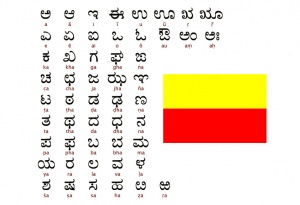Difference between revisions of "Language/Kannada/Pronunciation/Alphabet-and-Pronunciation"
m (Quick edit) |
Tag: Reverted |
||
| Line 2: | Line 2: | ||
Kannada is a Dravidian language spoken mainly by the people of Karnataka in the southwestern region of India. The Kannada alphabet (ಕನ್ನಡ ಲಿಪಿ) developed from the Kadamba and Chālukya scripts, descendents of Brahmi, which were used between the 5th and 7th centuries AD. Under the influence of Christian missionary organizations, Kannada and Telugu scripts were standardized at the beginning of the XIX<sup>th</sup> century. | Kannada is a Dravidian language spoken mainly by the people of Karnataka in the southwestern region of India. The Kannada alphabet (ಕನ್ನಡ ಲಿಪಿ) developed from the Kadamba and Chālukya scripts, descendents of Brahmi, which were used between the 5th and 7th centuries AD. Under the influence of Christian missionary organizations, Kannada and Telugu scripts were standardized at the beginning of the XIX<sup>th</sup> century. | ||
__TOC__ | __TOC__ | ||
* After completing this lesson, you can learn more about these related topics: [[Language/Kannada/Grammar/Vowels|Vowels: Pronunciation and Writing]], [[Language/Kannada/Grammar/Conjuncts|Learn about Kannada Grammar Conjuncts with a Kannada ...]]. | |||
==Kannada Consonants== | ==Kannada Consonants== | ||
Revision as of 23:09, 14 November 2023
Kannada is a Dravidian language spoken mainly by the people of Karnataka in the southwestern region of India. The Kannada alphabet (ಕನ್ನಡ ಲಿಪಿ) developed from the Kadamba and Chālukya scripts, descendents of Brahmi, which were used between the 5th and 7th centuries AD. Under the influence of Christian missionary organizations, Kannada and Telugu scripts were standardized at the beginning of the XIXth century.
- After completing this lesson, you can learn more about these related topics: Vowels: Pronunciation and Writing, Learn about Kannada Grammar Conjuncts with a Kannada ....
Kannada Consonants
| Letter | IPA |
|---|---|
| ಕ | [ka] |
| ಖ | [kʰa] |
| ಗ | [ɡa] |
| ಘ | [ɡʱa] |
| ಙ | [ŋa] |
| ಚ | [tʃa] |
| ಛ | [tʃʰa] |
| ಜ | [dʒa] |
| ಝ | [dʒʱa] |
| ಞ | [ɲa] |
| ಟ | [ʈa] |
| ಠ | [ʈʰa] |
| ಡ | [ɖa] |
| ಢ | [ɖʱa] |
| ಣ | [ɳa] |
| ತ | [t̪a] |
| ಥ | [t̪ʰa] |
| ದ | [d̪a] |
| ಧ | [d̪ʱa] |
| ನ | [n̪a] |
| ಪ | [pa] |
| ಫ | [pʰa] |
| ಬ | [ba] |
| ಭ | [bʱa] |
| ಮ | [ma] |
| ಯ | [ja] |
| ರ | [ra] |
| ಲ | [l̪a] |
| ವ | [ʋa] |
| ಶ | [ça] |
| ಷ | [ʂa] |
| ಸ | [sa] |
| ಹ | [ħa] |
| ಳ | [ɭa] |
There are 2 categories of consonant letters: the structured consonants and the unstructured consonants.
Kannada Structured Consonants
The structured consonants are classified according to where the tongue touches the palate of the mouth and are classified accordingly into 5 groups.
| Voiceless | Voiceless aspirate | Voiced | Voiced aspirate | Nasal | |
|---|---|---|---|---|---|
| Velars | ಕ (ka) | ಖ (kha) | ಗ (ga) | ಘ (gha) | ಙ (ṅa) |
| Palatals | ಚ (ca) | ಛ (cha) | ಜ (ja) | ಝ (jha) | ಞ (ña) |
| Retroflex | ಟ (ṭa) | ಠ (ṭha) | ಡ (ḍa) | ಢ (ḍha) | ಣ (ṇa) |
| Dentals | ತ (ta) | ಥ (tha) | ದ (da) | ಧ (dha) | ನ (na) |
| Labials | ಪ (pa) | ಫ (pha) | ಬ (ba) | ಭ (bha) | ಮ (ma) |
Kannada Unstructured consonants
The unstructured consonants are consonants that do not fall into the above structures:
- ಯ (ya)
- ರ (ra)
- ಱ (ṟa; obsolete)
- ಲ (la)
- ವ (va)
- ಶ (śa)
- ಷ (ṣa)
- ಸ (sa)
- ಹ (ha)
- ಳ (ḷa)
- ೞ (ḻ; obsolete).
Kannada Vowels
There are 13 vowel letters. When a vowel follows a consonant, it is written with a diacritic rather than as a separate letter.
| Letter | Diacritic | ISO | IPA |
|---|---|---|---|
| ಅ | ◌ | a | [a] |
| ಆ | ಾ | ā | [aː] |
| ಇ | ಿ | i | [i] |
| ಈ | ೀ | ī | [iː] |
| ಉ | ು | u | [u] |
| ಊ | ೂ | ū | [uː] |
| ಋ | ೃ | rū | [rɨ] |
| ಎ | ೆ | e | [e] |
| ಏ | ೇ | ē | [eː] |
| ಐ | ೈ | ai | [eʲ] |
| ಒ | ೊ | o | [o] |
| ಓ | ೋ | ō | [oː] |
| ಔ | ೌ | au | [oʷ] |
Video: Pronunciation
Kannada Online Virtual Keyboard
